On September 11, what’s left of the amazing jewelry Joan Sonnabend once wore and sold at her New York City gallery, Sculpture to Wear, goes on the block at Skinner Boston – including pieces designed by Max Ernst and Pablo Picasso as well as David Webb, Schlumberger, and many others.
Joan Sonnabend’s first gallery opened in 1972, across from the Persian Room at the Plaza Hotel, which her husband owned at the time. Along with jewelry designed by Picasso and Ernst, she sold jewelry by Man Ray, Alexander Calder, Hans Arp, Louise Nevelson, Georges Braque, and a host of other big-name artists whose work you will rarely find outside an auction house or museum now.
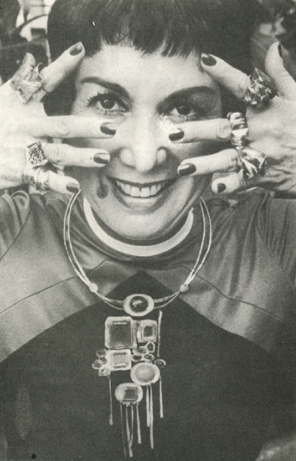
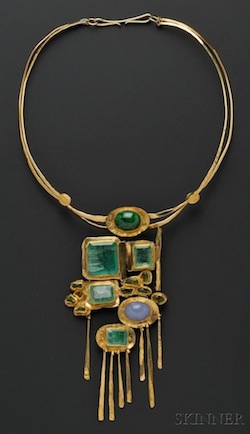
Along with commissioning jewelry from famous artists, Sonnabend championed contemporary studio jewelers. By the time I first spoke to her in 2000, she was living in Boston and a big fan of Miye Matsukata, who designed the necklace (in the sale, pictured above) for Sonnabend using stones she brought back from a trip to India. Other works by Matsukata and other designers from Janiyé feature prominently in the sale.
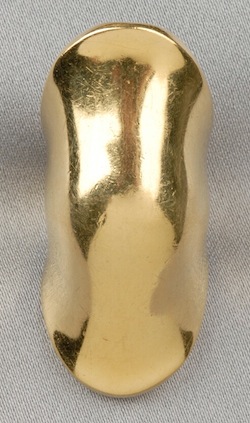
One of the designers Sonnabend took under her wing when she opened her NYC gallery was a young jewelry artist named Robert Lee Morris, then toiling in obscurity in his New Hampshire studio.
Having his designs sold at Sculpture to Wear beside works by the 20th century’s most famous artists was, needless to say, a life changer.
Sonnabend was impressed by his jewelry. “This was before Elsa Peretti and the whole artist jewelry thing,” she told me. “He was very inventive in those days, not too commercial.”
Morris opened his own New York gallery, Artwear, in 1977, and went on to collaborate with Calvin Klein, Karl Lagerfeld, and Donna Karan, among others. He will pay tribute to Sonnabend in a lecture on September 10 at Skinner – which (sorry, folks) booked within a couple days.
I’m sure he will credit her for launching his highly-successful career, as he has done many times over the years.
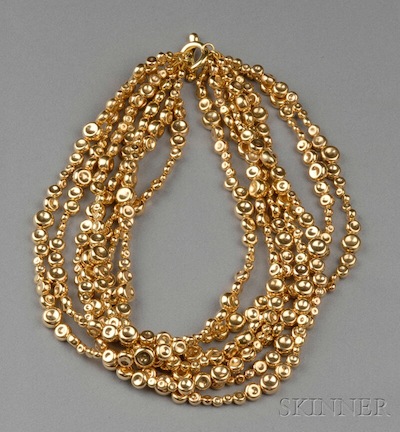
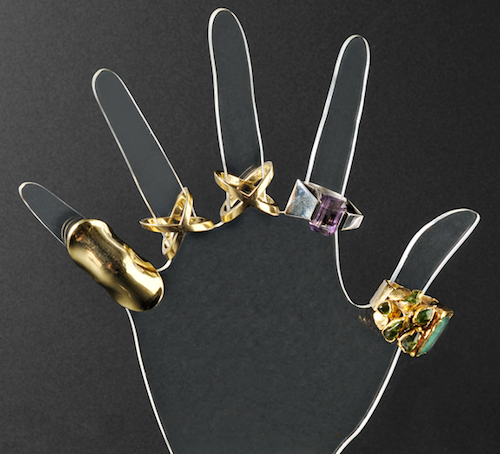
When I interviewed Sonnabend in 2000, I knew Calder’s jewelry had been carried by the Willard gallery in New York during the ’30s and ’40s, when Calder was still producing it, and it was a hot item even then.
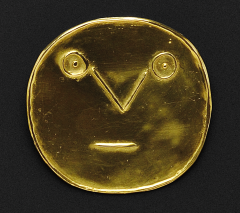
But he and Picasso were international icons by the 1970s and the Plaza Hotel would have been easily accessible for so many collectors. So I was amazed to learn she had so much of this work for sale in her centrally-located gallery – but had a tough time selling it.
“Mainly what I dealt with were European artists,” Sonnabend told me in 2000. “Mine was the first artist-jewelry gallery. It was a very unusual thing. There was no market for it. I created the market for it.”
It seems like there would have been a ready market of collectors who would want to buy Picasso, Calder or Man Ray jewelry by 1972, I told her.
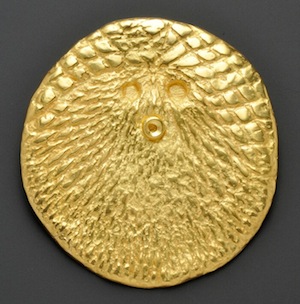
“You would think so,” she said. “It’s a very weird thing.”
Less surprising was the fact that she had to create demand for artists who were not necessarily household names, although they would have meant something to the New York art world. “Pol Bury made pieces made for us, Richard Liphold and Alex Katz. We carried Lichtenstein pins, jewelry by Nikki de Saint Phalle.”
Since she was carrying artworks by these artists, she began asking them to make jewelry as well. Diane Venet would do the same thing a couple decades later, culminating in the recent Picasso to Koons: The Artist as Jeweler exhibition at the Museum of Arts and Design.
Jewelry in that show included many pieces Sonnabend carried in her gallery 40 years earlier, including the dramatic spiral earrings Sonnabend wears (below), designed by Man Ray and produced by Gem Montibello in the early ’70s. “Certainly Man Ray’s jewelry was remarkable,” she told me.
“I’m an art dealer, so I was selling painting, sculpture and drawings,” she said. “Artist jewelry just came to me as something no one had ever done. As I was traveling around seeing art, I’d say [to the artist]: Why don’t you make a piece of jewelry for me?’ I thought, why shouldn’t we have art we can wear?”
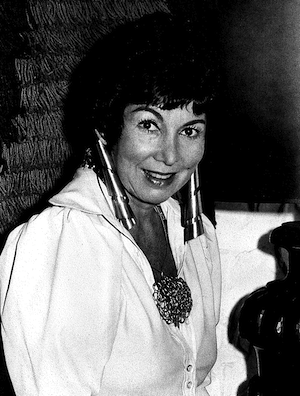
This culminated in Sculpture to Wear. “It wasn’t about diamonds, you understand, it was about aesthetics,” Sonnabend told me. “Some of it was rubber, some plastic, some platinum. Some pieces were in gold.”
Sculpture to Wear opened just as Picasso was collaborating with François Hugo, “a fantastic goldsmith and a close friend of his,” she says. “They had a close collaboration.”
“Picasso and Ernst did theirs early, around the time I opened the gallery,” she said. “What had to do with me is that I found them all.”
Unlike others who later specialized in this kind of artist-made jewelry, Sonnabend embraced the results of those collaborations. “Picasso made some as platters, little plates on footings like compotes. Then he made some of those same images as pendants and necklaces. He mostly did editions of 20, signed and numbered.”
A pendant designed by Picasso is in the sale (pictured above), but it was not one of the limited editions made by Hugo during the artist’s lifetime, and the price tag reflects this. There is a pendant designed by Ernst and produced by Hugo in an edition of 20 (above left) expected to sell for as much as $15,000.
She avoided buying and selling jewelry designed by Salvador Dali. “Those extraordinary early pieces are rare and hard to find,” she said. “Some of the Braques were like that too, didn’t have much to do with the artist, made by workshops and not the same thing as the artist getting involved in it. Dali interested me less as an artist. So much was iffy, like he worked. The world was flooded with phony Dalis.”
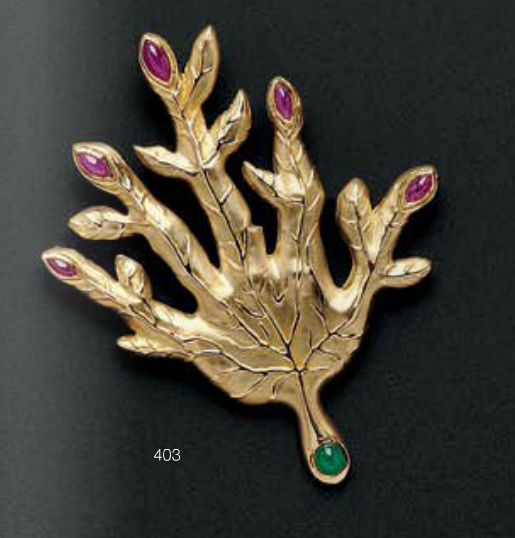
Interestingly, there are two pieces of jewelry in the sale I thought at first glance were Dalis. In fact, you might even call them “phony Dalis,” except they’re not being passed off that way. Turns out, they’re copies of two of those famous “extraordinary early pieces” – the leaf-veined hand brooch and the ruby-studded pomegranate heart – made with the same high-karat gold and precious gems of the originals, which are on display at the Dali museum in Figueres, Spain. These pieces are listed in the catalog as made by Henrik Kaston “after a design by Salvador Dali.” Uh, well. You’re not buying a Dali, folks, and that’s why these pieces are estimated below $5,000 and not $200,000.
Many of the pieces Sonnabend was commissioning and selling at Sculpture to Wear were featured in a 1973 exhibition held at The Institute of Contemporary Art in Boston, titled Jewelry as Sculpture as Jewelry. I have a copy of that catalog signed by Sonnabend, which I treasure, and it’s filled with black-and-white shots of mostly-nude models wearing rare pieces of jewelry by many different artists. Several copies are included in the September sale.
“I still sell a few of these pieces when I find someone who really cares about it,” Sonnabend told me twelve years ago. “There’s not very much. Usually I buy them back from people I’ve sold to over the years. Or when they die, I resell them.”
Now Sonnabend is gone and that jewelry is on the market once again. It’s appropriate that it’s being sold in Boston, where she made her home in the final decades of her life, and that Gloria Lieberman, a close friend and colleague of Sonnabend’s for many years, is organizing the sale. And it’s icing on the cake that Robert Lee Morris, her most notable protege, is delivering the pre-sale tribute.
“It was a tough battle for years,” Sonnabend once said of her passion for buying and selling artist-made jewelry. “Now people are beginning to understand it more.”
Related posts:
Alexander Calder’s jewelry: going mobile
Salvador Dali: bejeweled surrealism
Man Ray’s jewelry by Gem Montibello
Jewelry by modern artists: Picasso, Ernst, Braque & Man Ray

